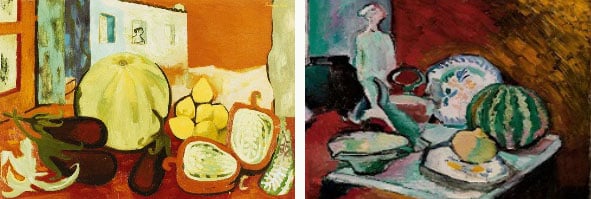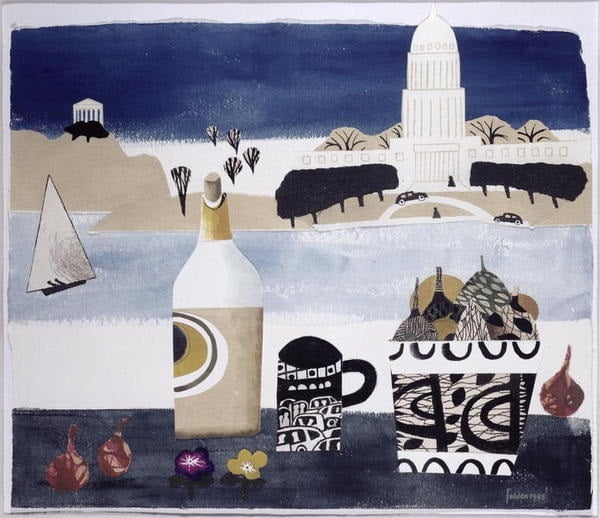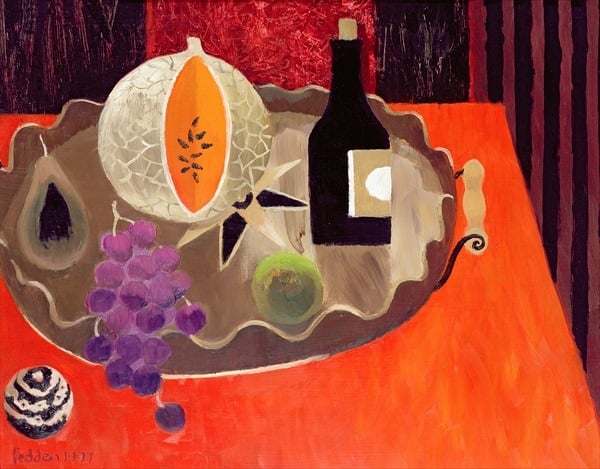
Mary Fedden OBE RA (1915-2012)
Look back at the celebrated British artist’s career and pick out a few observations on her style, technique and subject matter. Explore joyful, colourful works in the Bridgeman archive.
Mary Fedden (1915-2012) is described by some as ‘one of Britain’s finest and best-loved contemporary artists’[1]. Probably most well-known for her still-life’s, Fedden created an extensive body of work, painting daily well into her nineties from her London studio overlooking the Thames.
Bridgeman Images is delighted to represent the Estate of Mary Fedden with access to high resolution images of her work spanning decades. Bridgeman Images also represents the estate of her husband, Julian Trevelyan.
BIOGRAPHY
Mary Fedden left school to study at the Slade School of Art at the age of sixteen. One of her teachers at the Slade was Victor Polunin, who had worked as a designer with the Ballets Russes. After leaving the college she made a living teaching, painting portraits and producing stage designs for Sadlers Wells and the Arts Theatre.
At the outbreak of the Second World War Fedden served in the Land Army and the Woman’s Voluntary Service and was commissioned to produce murals for the war effort.
Fedden married the artist Julian Trevelyan in 1951. Under his tuition, her work began to show the influences of Braque and Matisse in its organisation of flat picture planes and separate still-life objects. From 1956 to 1964 she taught at the Royal College of Art, where she was the first female tutor, and where her pupils included David Hockney and Allen Jones.
STYLE
With a career spanning almost nine decades, Fedden’s evolving style can be seen throughout. She seemed to ‘marry English sensibility with a modern European one’[2], the impact of artists such as Ben Nicholson and Christopher Wood having the most noticeable impact on her style.
The style that pushed her to the front of British contemporary painting was only to appear in the second half of her career. In the pre & post war period she described her work as being ‘rather heavy still-life’s and flower paintings’[3]. There are however elements in the early work of what will later become her distinct style; the objects pushed to the front of the plane, the floating, unmanifested support and a distinct landscape behind, such as in Charlotte’s Jug (2008).
THE SURREAL
It should be noted that there was ‘a quietly surreal, enigmatic streak’[4] that continued throughout her career. That ‘surreal’ influence should not be underestimated, especially in works such as Cat by a Full Moon (1988). This surrealism would surely have derived from Julian and his friends; artists such as Miró and Calder whom he met during his time in Paris.

CH876799 Cat by a Full Moon, 1991 (w/c heightened with white on paper) by Mary Fedden, © Christie’s Images
ABSTRACT
During an interview in 2008 with PAINTERS ONLINE Mary Fedden talks about her search for inspiration, ‘each of my paintings is a mixture of things that I’m looking at, and my thoughts and imagination’[5]. As her work developed she began to explore not just singular objects in a still life but how they worked together, how their individuality built the composition: ‘I use objects a lot, but I never set up a conventional still-life composition and work from that’.
It is in her work of the 50’s and 60’s that Fedden is at her most abstracted, ‘her work began to show the influences of Braque and Matisse in its organisation of flat picture planes and separate still life objects’[6]. Here, in Fruit in Albatax (1956), gone are the defined lines and true to life colours of her earlier work, in favour of looser brush-strokes and a hue that tints the whole composition; the links to Mattise‘s Still Life with Melon are obvious.

Left: Fruit in Albatax, 1956 by Mary Fedden (1915-2012)
Right: Still Life with Melon, 1905 by Henri Matisse (1869-1954)
A MERGING OF GENRES
If her still-life’s were described as anglicised, her landscapes are certainly not. Julian and Mary traveled extensively all over Europe as well as to the Middle East and India. From these trips she formed a huge body of sketches, landscapes mostly, from which she drew inspiration when back in her studio. These drawings and sketches are almost always done in pen or pencil, devoid of any colour. It allowed her to choose her own colour as a starting point instead of being influenced by the original, ‘at the start she has in mind the colour key… whether it is going to be a very dark picture, or essentially a red, blue or perhaps grey one’[7].
During the late 80’s and early 90’s Fedden began to explore a more representational style with images such as Highland Sheep (1992). Crucially it is not a still life and consequently seems to tell much more of a story than her other works. She has still retained her technique of ‘colouring’ the entire picture however, here white dominating the composition.
OBJECTS
In the later part of her career Fedden withdrew slightly from her experimentation with abstraction and instead focused on the individuality of objects. In works such as The Inlaid Tray (1997) each item is meticulously observed but in a distinctly separate way. The objects do not seem to relate (e.g. overlapping) and are only brought together by a general coloured hue. This increased isolation of the subjects is highlighted by her creation of form with distinct edges, not the blurred lines of her earlier work.
A painting of this genre must live up to its name; requiring both stillness and life in order to achieve enduring recognition. The lack of either of these therefore would produce a picture that is too frantic, not allowing for contemplation of the objects chosen, or, one that is too hesitant and laboured in its composition. Fedden carefully navigated this tricky path, allowing for the successful commercialisation of her work and ensuring her anniversaries will be celebrated for years to come.
Find out More
Mary Fedden’s work is held in collections all over the world, including those of the Royal Collection and Tate. She was elected a royal academician in 1992, and made OBE in 1997. Browse all artworks.
Bridgeman Images is proud to administer the copyright on Mary Fedden’s entire body of work as a Bridgeman Copyright Artist (BACS). Mary Fedden is also represented by the Artists’ Collecting Society, for Artists’ Resale Rights.
To discuss licensing images please email uksales@bridgemanimages.com.
Related Articles
Rhythm-on-Thames: ‘Artists and Music’ at the Bohun Gallery
Sources
[1] Clark Art Ltd
Save
Save
Save
Save




